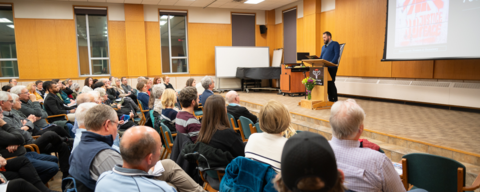
Paint as Protest
In streets marked by division, graffiti often emerges as an unfiltered voice of resistance and reflection, yet it can often be overlooked or seen as mere vandalism. During the 2024 Eby Lecture at Conrad Grebel University College, Professor Eric Lepp invited the audience to look beyond the paint and lend an ear to the voices of those who create graffiti. Professor Lepp painted a vivid picture of graffiti as a tool for documenting history, reclaiming space, and amplifying marginalized voices using examples from Cyprus, Northern Ireland, and Canada.

Cyprus remains a "frozen conflict," with the political and territorial disputes between Greek and Turkish Cypriots remaining unresolved despite decades of diplomacy since the outbreak of war in 1974. After the war was over, the United Nations established the Green Line to separate the two groups. In 2003, checkpoints were opened, allowing limited cross-communal contact, but the underlying physical, political, and cultural divides still exist. Graffiti has become a key form of expression in this context, especially along the Green Line in Nicosia.
Dr. Lepp and his team explored how graffiti in Nicosia serves as a reflection of the island’s ongoing conflict. Messages on the walls of the Green Line highlight decades of unresolved tensions. Some messages are written in Greek or Turkish, addressing internal audiences, while others use English to capture international attention. The placement of graffiti near areas, such as the buffer zone highlights how location shapes its meaning. These markings are not random, they are deliberately placed to communicate with specific groups. Over time, as old graffiti is painted over, these spaces also show how attitudes and identities shift in response to ongoing conflict.
In Canada, graffiti has become a tool for addressing colonial history. In 2021, the discovery of 215 unmarked graves at the site of the Kamloops Indian Residential School triggered widespread grief and outrage across the country. This finding highlighted the ongoing trauma from Canada’s residential school system and reignited calls for accountability and reconciliation. The announcement sparked vigils and protests, many symbolized by children’s shoes, a visual reminder of lives lost and forgotten. It also led to red paint being repeatedly thrown on Queen Victoria’s statue in Kitchener, Ontario. At the same time, the City of Kitchener's Downtown Art Walk features approved murals that beautify public spaces. While these murals celebrate culture and creativity, including the artistic skills of Indigenous artists, they lack the raw emotion of protest graffiti. This contrast shows how institutionalized art tells different stories about the same community.

A unique connection can be made between Dr. Eric Lepp’s work and Margruite Krahn’s Resurfacing Exhibit at the Grebel Gallery. Dr. Lepp studies and explores layers of graffiti and murals on walls to uncover stories of conflict and resilience, while Margruite examines layers of paint on floors to explore women’s creativity and expression in traditional spaces. Both reveal how layers tell powerful stories about people and communities. Together, their work shows how spaces hold untold stories of identity, creativity, and connection.
Graffiti’s temporary nature is a limitation and a strength. Paint fades, walls are cleaned, and new works appear, reflecting the evolving narratives of the societies that created them. Beyond its aesthetic, graffiti serves as a medium for marginalized voices and a lens through which we can understand the complexities of conflict and identity. Graffiti reminds us that stories of resistance and hope are written not only in history books but also on the walls that surround us.